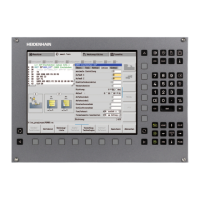812 HEIDENHAIN Technical Manual MANUALplus 620
Clean surface
Definition of the term "surface":
A clean and smooth surface has the highest priority
Application: Finishing
Oscillations in the axes must be damped, since following errors of 1 µm are
still visible on the surface
Tolerances are typically between 0.01 and 0.02 mm (may be slightly
exceeded in order to achieve a better surface)
Settings guidelines for "surface":
Low jerk values (MP_maxPathJerk)
Switch off consideration of the tolerance for curvature changes
(MP_pathTolerance)
High jerk values for MP_axJerk so that no limitations take effect (example:
test up to a value of 1000)
Accuracy
Definition of the term "accuracy":
Maintaining the tolerances has the highest priority
Slight oscillations can be seen on the surface
Tolerances are typically between 0.005 and 0.01 mm.
Settings guidelines for "accuracy":
Lower jerk values than for "speed"
Ideally, circular paths should be checked with a KGM grid encoder from
HEIDENHAIN. However, in many cases the circular interpolation test with
the integrated oscilloscope or TNCopt suffices.
MP_pathTolerance = 1 (consideration of tolerance limits at curvature
changes)
The adjustment should be tested with suitable NC programs. The TNCopt
software from HEIDENHAIN features suitable NC programs for this. The
advantage is that the speed and the contour deviations can be seen directly.
Speed
Definition of the term "speed":
Surface quality is secondary; short machining times have the highest priority
Application: Roughing
Tolerances typically between 0.1 and 0.2 mm
Settings guidelines for "speed":
Filter selection
• For large tolerances (greater than 50 µm), preferential use of triangle
filters
High jerk values
The adjustment should be tested with suitable NC programs. The TNCopt
software from HEIDENHAIN features suitable NC programs for this. The
advantage is that the speed and the contour deviations can be seen directly.

